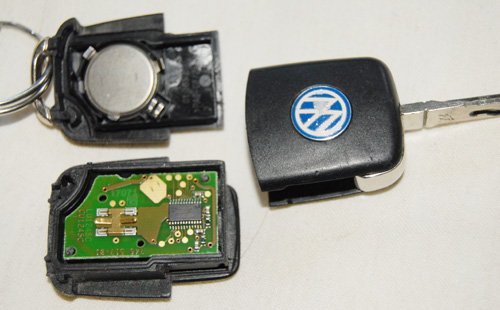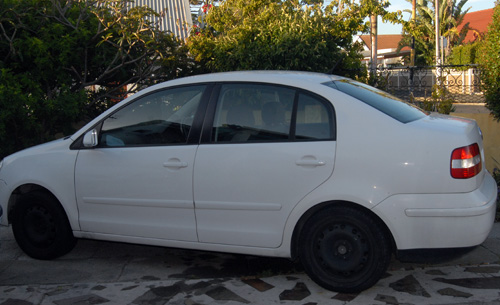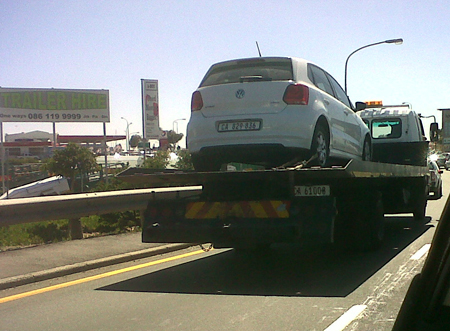VW - DRIVE BY WIRE (Drive-by-Wire)
If you arrived on the VW Polo website because you searched for Drive by Wire (DBW), EPC, or EPC light or engine won't rev, Steer-by-Wire, or limp mode, then you have certainly arrived at the right place. There are several definitions for ECP, the first of which will be explained, is Electronic Parts Catalog (EPC).EPC stands for Electronic Parts Catalogue (EPC) and all Audi, Volkswagen, Skoda and SEAT parts are listed in ETKA V7.2 EPC (Electronic Parts Catalogue). This catalogue is purchasable online and downloadable but the file is huge. Companies like Mercedes Benz, Toyota, Enigma, Attrakt among many, many others host computer based electronic catalogs of the individual auto parts and accessories that make up their engines, cars, tractors, specialized machinery and farming equipment etc. Restated, an EPC is a catalogue in electronic format much like CVS data or a database file or similar, that can be downloaded or is accessible online.
Then there is the second type of EPC - Electronic Parts Catalog (EPC) software. MultiCat and Msys.EPC are companies that specialize in the software that can display an exploded view of an assembled device. For example, the exploded view of an engine, or gearbox, or cylinder head, showing the individual bolts and nuts, flanges, hoses and brackets, etc. and their component part numbers.
Thirdly, there is also the Electronics Parts Catalog (EPC) which is an electronic list or database of semiconductor components, from diodes to transistors to integrated circuits to thyristors, etc... This EPC is often called and equivalents book or catalog and hosts the specifications of semiconductors from several manufacturers. A typical EPC is the RS Electronic Components and Tools Database. This EPC doubles up as the third type of EPC which is the Electronic Product Code. Component Product Codes look like, 1N4148 or BC337, MCP2515, TYN812RG, etc... for electronic components.
However, there are many more EPC definitions, some of them can be found at the end of this blog. I could explain all of them individually but none has any relevance to the subject at hand, viz EPC - Drive by Wire. Drive-by-Wire also know as DbW, Steer-by-Wire "x-by-wire" or simply "by-wire".
DRIVE BY WIRE
And finally, the Electronic Power Control (EPC) that freaks out almost each and every VW 1.6 Polo, Audi TT, Skoda, SEAT and Golf TDI, owner. Most vehicles with Drive by Wire [Drive-by-Wire (throttle control)] usually have a Electronic Power Control (EPC) indicator lights on its dashboard which lights up when there's a problem with the Drive-by-Wire system. This would involve the two accelerator pedal sensors G79 and G185 and in some cases the two sensors G187, G188 inside throttle control valve body - control actuator. [As discussed in my previous blogs] When the engine idles, neither the Throttle Valve Angle Sensor nor the Accelerator Pedal Position Sensor are monitored for faults by the ECU, as such, the engine does not respond to accelerator input but will limit engine to 1200 RPM.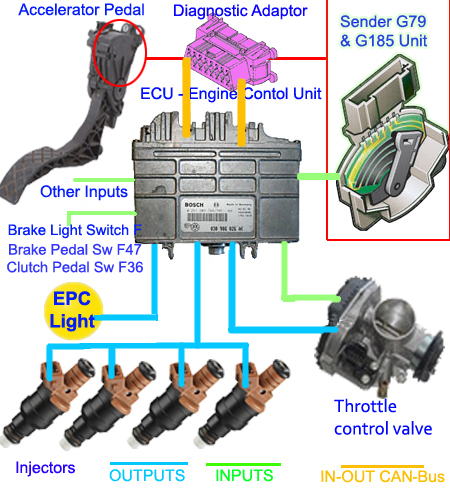 | |
|
The CAN-Bus bidirectional connection is marked in orange. Some of the other inputs like Knock sensors and Lambda regulator and Engine Speed Sensor unit can also cause the EPC light to come on. If the Engine Speed Sensor unit is responsible, it will reset itself after a while and if the Lambda regulation is faulty the vehicle will smoke and turn on both MIL and EPC lights, but if the Drive-by-Wire - DBW (not drive by cable) system is faulty then only the EPC light will be on.
Both the accelerator sensors and the throttle valve sensors work on the same principle since all 4 of them are potentiometers. The input voltage is 5 Volts and the increments are in millivolts implying that there is an acceleration range of between 0 and 5000. Throttle valve angle sensor 1 and Throttle valve angle sensor 2, Accelerator position sensor 1 and Accelerator position sensor 2 sliders makes contact with the resistive track and outputs the appropriate voltage level to the ECU. These resistive tracks are prone to go faulty since they are gold plated contacts running on gold plated copper tracks etched on a PCB. Over time the contacts wears right through the gold and copper plating, only making contact with the bakelite or fibreglass substrate. This type of potentiometers are less reliable than ceramic thick-film potentiometers.
When the EPC warning light goes on and your acceleration goes limp and the engine won't rev-up there is an easy cure but there may be exceptions. Get the car home even if it means driving really slowly in "Limp Mode". Once home, disconnect the battery for about 15 minutes or so, but not more than 20 minutes then reconnect. NB! do not disconnect the Live terminal, disconnect the Earth terminal. If the battery is disconnected for more than 20 mins you will lose your radio settings since the radio also participates in volatile and non-volatile memory of the CAN-Bus.
Reconnect the battery but make certain that the ignition is off. Once this is done, turn on the ignition so that the dashboard lights go on but do not start your car and DO NOT touch your accelerator pedal. After about 5 minutes the throttle body will aligns itself. After 10 minutes turn off the ignition, wait for 2 mins then start the car and let it idle for abut 2 minutes as well. By now, the EPC warning light should be off and the engine will rev as normal.You may have to to this twice. If this worked for you, please do give me some feedback with a comment.
 |
| VW Airbag diagnostics |
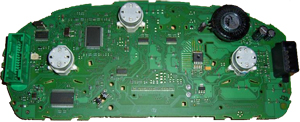 |
| VW Instruments - Immobilizer |
DON'T FORGET to VISIT
VW, SEAT SKODA and AUDI OWNERS found the following sites interesting.
expowp, photojani, controversy365, nerdytoys, lovelifelovehealth, sightsofcapetown, sowpbox, electroniques, blogspot-at, photo-magix, godssites, glycomix, arth-ritis, forex-bid, foodsofthecape, languagesbarrier, pimpyocar, e-gimos.
COME MORE EPC DEFINITIONS
EPC - Engineering, Procurement & Contracting,
EPC - Engineering, Plant Construction,
EPC - European Paralympic Committee,
EPC - Electronic Product Code,
EPC - Event Promotional Council,
EPC - Energy Performance Certificate,
EPC - Engineering, Procurement and Construction,
EPC - Event-driven Process Chain,
EPC - Evolved Packet Core,
EPC - European Patent Convention,
EPC - Eastern Provincial Council,
EPC - Electronic Poetry Center,
EPC - European Policy Centre,
EPC - European Political Community,
EPC - European Political Cooperation,
EPC - Evangelical Presbyterian Church
EPC - Export Promotion Council,
EPC - Electricity Plant Controller,
EPC - ElectroPlating Cathode,
EPC - European Payments Council,
EPC - Electronic Packet Collision,
EPC - Electrical Professionals Council,
Etc...,
